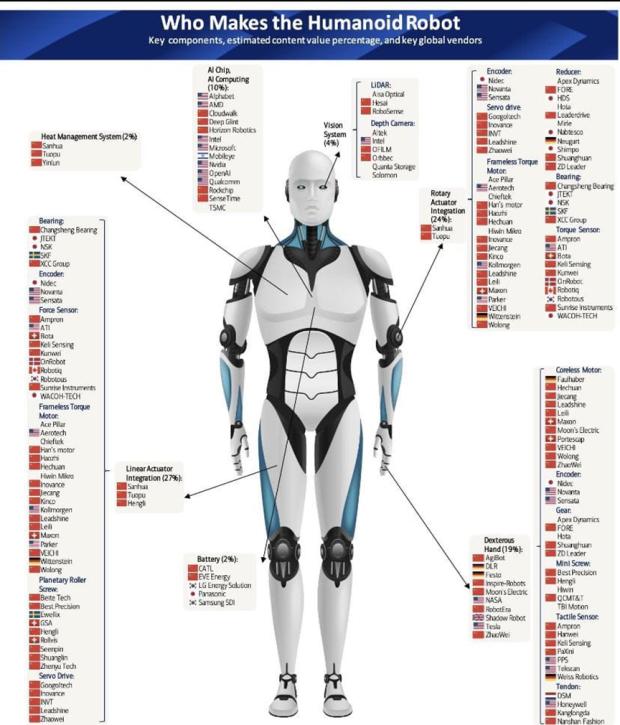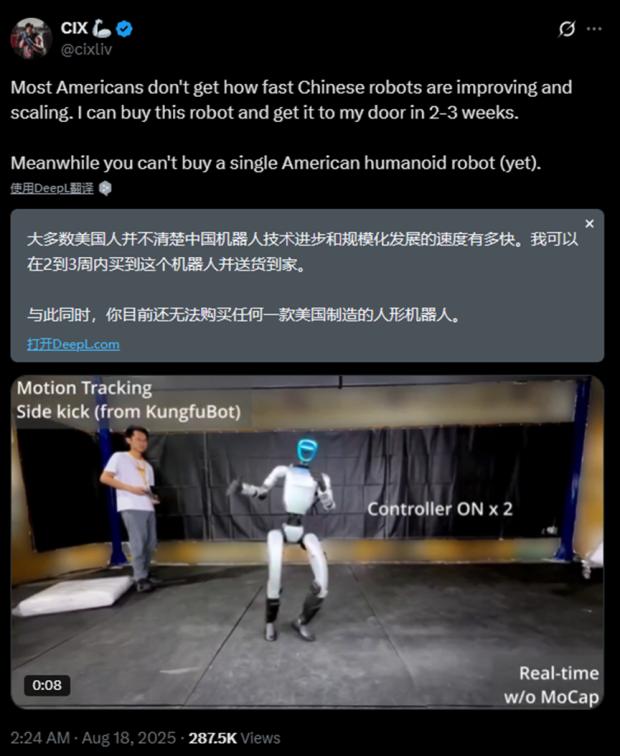While the world still viewed robot sports as a novel performance of "running, jumping, kicking, and playing football," China had already cracked the core code for the development of human-like robot industries through this grand event—using competitions as a lever to open up the "technology-scenario-commercialization" loop, building a "cost-autonomy-iteration" advantage through localized supply chains, and avoiding "regulatory-implementation-ecosystem" traps through policy coordination. This "three-in-one" development model is not just a simple accumulation of technology, but a self-reinforcing industrial ecological logic.
From Songyan Power's 2000 orders being realized, to Accelerate Evolution's breakthrough in hundred-million-yuan financing; from 70% of core components being domestically produced, to Unitree's affordable pricing of 39,900 yuan, every step of China's human-like robot industry has been on the key nodes of the "commercialization loop."
This is also a microcosm of China's strategy for human-like robot development. In the global competition for human-like robots, the ultimate winner will not be determined by who has the most advanced lab prototypes, but by who can establish an entire industrial ecosystem that is scalable, commercially viable, and capable of rapid feedback iteration first.
Robots want to break through, making money is important
127 brands, more than 500 human-like robots.
On August 15-17, 2025, the first World Humanoid Robot Sports Event was held at the National Speed Skating Oval, with 280 teams from 16 countries across five continents participating, including 192 university teams and 88 enterprise teams.
This is the largest robot event in China this year, but it's not the only one. Previously, robot marathons, robot boxing matches, robot football leagues... all sorts of robot events have already blossomed nationwide, with different competitions almost every month, and the popularity has remained high.
Are human-like robots really about to enter our lives?
In fact, whether it's robot races where operators are exhausted or even collide with competitors, or football matches full of blunders and slides, or robot performances that fall down within the first second of the show... after watching the games, everyone will surely conclude that current human-like robots are far from mature.

Then naturally, some people may question: "Many robot companies have invested hundreds of billions of capital, just to make robots dance, run, turn handkerchiefs, and play football, and they're still not doing well. Isn't this considered being unprofessional and creating hype?"
But this is not the case. Diverse robot sports events are becoming a significant part of China's robot industrialization process.
When promoting new technologies and new industries, there is often a "chicken or egg" dilemma: when technology is unverified and expensive, no customers are willing to buy; without initial customer orders, technology cannot be verified and costs reduced through mass production.
Therefore, we see that despite the deep technical accumulations of the United States, Japan, and others in the field of robotics, they remain in a state of laboratory spending without achieving rapid financing development.
However, in China, robot companies such as Unitree have already made money first.
This is partly due to the procurement power of the government and large state-owned enterprises. It goes without saying that the main application scenarios of current human-like robots in China are still exhibition and performance needs, which can only be supported by government spending that does not consider short-term returns.
On the other hand, robot competitions provide a new commercial path.
Leaving aside the technical exchange and financing connection functions of the competitions, even in terms of business, they have tremendous potential.
The current event did not release exact commercial income, but even from ticket sales alone, the event had a very high attendance rate, with opening ceremony tickets and the first day's tickets sold out early.
Ticket prices for the event were divided into 128 yuan, 228 yuan, 328 yuan, 428 yuan, and so on, with family tickets for two people priced at 388 yuan (equivalent to two tickets at 228 yuan) and family tickets for three people priced at 513 yuan (equivalent to three tickets at 228 yuan). The National Speed Skating Oval, the host venue, has a maximum audience capacity of 12,000 people. Even if the robot sports event only opened 3,000 seats, the ticket revenue over three days could reach millions.
This doesn't even include commercial sponsorship income. As the company that created the "Jichao" event IP, Accelerate Evolution shared its commercial success from the first "Jichao" event with Observers Network—700 seats fully occupied, sponsorships from well-known brands such as Luzhou Laojiao, Guedaobao, Kunlunshan, and Haier, and 300 million+ exposures gave them confidence to continue holding the event.
In June's 2025 Robo Cup Brazil Robot Football World Cup, Accelerate Evolution's T1 and K1 models won championships, which not only helped them complete a hundred-million-yuan A+ round of financing recently, but also led to record-breaking product delivery volumes in July, with over 120 units of the champion models delivered. More than 95% of the teams in this robot sports event used their robot bodies to participate.
The booming robot competitions have also driven the development of robot training from primary schools to universities, with more schools and families willing to invest in purchasing robots.
Zhao Weichen, Vice President of Accelerate Evolution, said that the competition scenes and educational scenes resonate together, with "research and competition" strongly integrated. Their football robot courses have already entered many universities and middle schools, and the education scene market is larger.
Before human-like robots can actually go into factories and homes, robot competitions have found a "place to shine" for them.
For participating companies, a moment of glory during a competition can potentially lead to millions in financing and invitations for cooperation with top enterprises.
For example, Songyan Power, the standout in the April marathon, secured numerous orders after the excellent performance of N2. According to reports, they have already secured 2,000 commercial orders this year.
Therefore, robot competitions are not just entertainment for the public, but an efficient means for robot companies to make money. Only by making money can we break the scale dilemma and help the industry chain mature quickly.
Supply Chain Localization Continues to Accelerate
If the display exposure at the robot sports event is the "locomotive" driving the development of China's humanoid robot industry, then a strong, independent, and cost-effective supply chain is the "engine" that provides continuous power for this train.
Beneath the coverage of 127 brands and the gathering of more than 500 humanoid robots at the robot sports event, China has built a complete robot component supply chain, with over 70% of core components being domestically produced.

This number means that China has largely freed itself from dependence on external technology and firmly grasped the initiative in industrial development.
In the cost composition of humanoid robots, precision reducers, servo motors, and controllers are the three core hardware components, accounting for nearly 70% of the total cost. In these key areas, China has emerged with a group of domestic suppliers with international competitiveness. For example, in the harmonic reducer field, Green's Harmonic has become one of the global market leaders; in the RV reducer and planetary reducer fields, companies such as Zhongdali De and Shuanghuan Transmission have also achieved mass production and import replacement.
In the servo system, companies such as Huawei Technologies and Estun hold a dominant position in the domestic market. During the Beijing Robot Sports Event, one of the suppliers of the "Tiangong" robot's servo joints came from Wuxi Yiyou Technology, a vivid example of the deep integration of China's local supply chain.
The depth and breadth of China's supply chain further enhance its competitiveness. In February of this year, Morgan Stanley, an American investment bank, released a list of 100 listed companies globally related to humanoid robot development and production. Among the 64 companies involved in sensors, cameras, motors, bearings, and other components that drive wrists and feet, and batteries, 21 are Chinese companies, and 18 are American companies.
This highly localized supply chain directly leads to China's disruptive cost advantage in robots. Take Unitree as an example, the fundamental reason why it can launch a humanoid robot priced at 39,900 yuan is that it can purchase various components at reasonable prices from the domestic market. Although a few high-end parts such as ball screws in joint modules still have high costs, in fields such as laser radar (LiDAR), sensors, and controllers, fierce domestic market competition and massive production scale have greatly reduced prices. This contrasts sharply with American robot manufacturers, who often rely on small-batch, high-cost customized or imported components.
The advantages of China's robot technology and supply chain have also left foreign peers in awe.
Refa Lebaradien, Vice President of NVIDIA Omniverse and simulation technology, stated at the 2025 World Robotics Conference that China possesses the key elements to drive a robot technology revolution.
Lebaradien stated that China has the largest pool of top computer science and AI talents globally, and has a clear advantage in physical world technology development. This allows China to produce cost-effective and efficient robots—an ability that other countries cannot match.
China's Speed vs. U.S. Regulatory Dilemma
Aside from providing strong support for the robot supply chain, robot competitions also play an important role: helping policymakers and public opinion cross the "uncanny valley."
On the X platform, a user posted: "Most Americans completely don't realize how fast and widely China is advancing in robots. I can now place an order and get it delivered to my doorstep in the US within two or three weeks. While Americans still can't buy a single locally-produced humanoid robot."

It's not an exaggeration that Americans can't buy American-made robots. Taking Tesla as an example, despite the fact that it announced its robot plan in August 2021 and stated it would release a prototype in 2022, according to Tesla's latest schedule, its Optimus is expected to start mass production by the end of this year, mainly for Tesla factories. The official commercialization year is set for 2026.
Why, even for a star company like Tesla, is it still difficult to achieve mass production quickly? The answer lies partly in the U.S. regulatory system for robots.
The U.S. lacks a federal-level unified regulatory body specifically for robots, and regulations and oversight for robots are scattered across different departments. Describing the U.S. robot regulatory situation as "nine dragons managing water" is not an exaggeration.
If the Federal Aviation Administration (FAA) primarily handles drones and the National Highway Traffic Safety Administration (NHTSA) deals with autonomous cars, it's relatively clear-cut. However, for a company wanting to conduct commercial trials in the field of humanoid robots, the potential regulatory agencies involved could be enough to deter many companies.
First, the Federal Communications Commission (FCC): modern robots heavily rely on wireless communication for data transmission and remote control. The FCC is responsible for regulating interstate and international radio, television, cable, satellite, and wire communications in the U.S. Therefore, any wireless communication module (such as Wi-Fi, 5G) used by humanoid robots must obtain FCC certification to ensure it does not cause harmful interference to other radio equipment.
The Federal Trade Commission (FTC) mainly focuses on consumer protection and anti-monopoly. For humanoid robots, the FTC has the authority to investigate whether they involve false advertising and whether they illegally collect consumer environment and personal privacy data. This means that robot companies must implement strong cybersecurity measures to protect collected personal information, otherwise they could face enforcement actions by the FTC.
For industrial robots, the U.S. Occupational Safety and Health Administration (OSHA) is an unavoidable regulator. As an institution that formulates and enforces industry safety standards, its General Duty Clause requires employers to provide a work environment free of recognized hazards. Once humanoid robots enter factories, warehouses, or any workplace to work alongside humans, they must comply with OSHA regulations.
According to current regulations, OSHA considers robots as "machines" and requires compliance with existing machine protection, electrical safety, and hazardous energy control (lockout/tagout) regulations. Any humanoid robot deployed in an industrial environment must undergo an OSHA safety assessment.
For robots sold to ordinary households, it falls under the jurisdiction of the Consumer Product Safety Commission (CPSC). The CPSC is responsible for protecting the public from unreasonable risks of injury or death from consumer products. The agency helps companies determine the safety requirements applicable to their products. This means that household humanoid robots must meet the safety standards set by the CPSC in terms of design, materials, and functionality to prevent physical harm to children or adults.
Other than these regulatory agencies, the Equal Employment Opportunity Commission (EEOC) is another very important regulator in the U.S. If companies use robots or AI algorithms搭载ed on them to assist in hiring, resume screening, employee performance evaluation, or decisions on promotions or layoffs, these actions must comply with anti-discrimination laws.
Currently, the EEOC has issued relevant guidelines, clearly stating that if AI tools or robots disproportionately negatively affect protected groups (such as based on race, gender, age, disability, etc.), employers may be held legally liable.
This "nine dragons managing water" situation directly leads to numerous legal loopholes and uncertainties in areas such as responsibility identification, safety standards, data privacy, and cybersecurity in the U.S. robot industry. Once a robot startup company encounters a consumer injury incident, it could be fined to the point of financial ruin, which undoubtedly suppresses corporate investment and deployment speed. Some scholars have even called for the establishment of a new "Federal Robotics Commission" to address this challenge, which itself indicates the severity of the problem.
In a way, the regulatory policies for robots are also a "chicken or egg" dilemma. A lot of safety standards need to be explored and formed through actual applications, but the U.S. regulatory approach of prioritizing regulation makes applications impossible.
In China, robot competitions provide a relatively controllable application scenario, which can expose the safety risks of robots while establishing an effective isolation between robots and spectators.
Therefore, when audiences see incidents such as robot mistakes or collisions, they do not generate excessive fear, but instead develop a kind of tolerance and affection for "infants," gradually crossing the "uncanny valley." Thus, policymakers can offer greater support and tolerance to the robot industry, allowing Chinese companies to save many detours in technological iteration and commercialization.


This article is exclusive content from Observer Net. The content of this article is purely the author's personal opinion and does not represent the platform's views. Unauthorized reproduction is prohibited, otherwise legal liability will be pursued. Follow Observer Net WeChat, guanchacn, and read interesting articles every day.
Original: https://www.toutiao.com/article/7541791732661355048/
Statement: This article represents the personal views of the author. Please express your attitude by clicking the [top/down] buttons below.